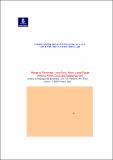Por favor, use este identificador para citar o enlazar a este item:
http://hdl.handle.net/10261/78179COMPARTIR / EXPORTAR:
 SHARE
BASE SHARE
BASE
|
|
| Visualizar otros formatos: MARC | Dublin Core | RDF | ORE | MODS | METS | DIDL | DATACITE | |

| Campo DC | Valor | Lengua/Idioma |
|---|---|---|
| dc.contributor.author | Fernández, Margarita | - |
| dc.contributor.author | Soria-Castro, Irene | - |
| dc.contributor.author | López-Peláez, Marta | - |
| dc.contributor.author | Martín-Duce, Antonio | - |
| dc.contributor.author | Alemany, Susana | - |
| dc.date.accessioned | 2013-06-17T09:14:47Z | - |
| dc.date.available | 2013-06-17T09:14:47Z | - |
| dc.date.issued | 2010 | - |
| dc.identifier | isbn: 978-81-7895-477-6 | - |
| dc.identifier.citation | Emerging signaling pathways in tumor biology: 25-41 (2010) | - |
| dc.identifier.uri | http://hdl.handle.net/10261/78179 | - |
| dc.description | Capítulo 2.-- Editor: Pedro A. Lazo. | - |
| dc.description.abstract | Cot, as well as its murine homologue tpl-2, was discovered in a COOH–terminal truncated form that unmasks the transformation capacity of the protein. The COOH-terminal domain of wt Cot contains an amino acid sequence that is a recognition signal for degradation via proteasome, besides, this domain of wt Cot is also an autoinhibitory domain of the specific activity of the wild type form. These data explain the transformation capacity of trunc-Cot/tpl-2, that when overexpressed is capable of activating several MAP kinases pathways as well as AP-1, NFAT, and NF-κB2 transcriptional activities. Earlier sobreexpression experiments lead to the proposal that Cot/tpl-2 could be involved in proliferative signalling, but the use of new technologies such as genetically modifies mice and interference RNA end up with the already accepted hypothesis that Cot/tpl-2 is involved in immune innate and adaptive processes. Cot/tpl-2 is activated in response to the activation of the TLR/IL-1 receptor superfamily as well as in response to the activation of some receptors of the TNF family. Independently of the cell system it is accepted that in resting cells Cot/tpl-2 forms a stable and inactive complex with p105 NF-κB among other proteins to protect it from degradation, adequate TLR/IL-1R stimulation induces the activation of the IKK complex that targets p105 NF-κB to be rapidly degraded by the proteasome pathway to p50 NF-κB, a subunit of the NF-κB transcription factor. Consequently Cot/tpl-2 is released from the complex and susceptible to transduce the activatory signal, leading to the activation of the MEK1-Erk1/Erk2 pathway. However, actually it is not completely understood all the requests that Cot/tpl-2 needs to be fully active and to this end it is also accepted that Cot/tpl2 requires to be phosphorylated. In addition the possibility that the requirements vary from cell system to cell system cannot be excluded. Physiologically, Cot/tpl-2 is involved in provoking innate immunity to establish adaptive immunity. In fact it is the unique MAP3K that activates Erk1/Erk2 when the TLRs/IL-1 receptors are activated and mediates the production of proinflammatory cytokines, such as TNFα, IL-1, or IL-6. More recently it has been shown that Cot/tpl-2 has the capacity to regulate the balance between Th1 and Th2 cytokines. All these data indicate that, although mutations in Cot gene result in the expression of a protein linked with cell malignancies, physiologically wt Cot/tpl-2 is involved in innate and adaptive immunity. | - |
| dc.description.sponsorship | Our research is supported by the Plan Nacional (SAF 2008-00819) and Mutua Madrileña. | - |
| dc.language.iso | eng | - |
| dc.publisher | Transworld Research Network (Trivandrum, India) | - |
| dc.rights | openAccess | - |
| dc.title | The biological function of the proto-oncogene Cot/tpl-2 | - |
| dc.type | capítulo de libro | - |
| dc.relation.publisherversion | http://www.trnres.com/ebookcontents.php?id=72 | - |
| dc.date.updated | 2013-06-17T09:14:47Z | - |
| dc.description.version | Peer Reviewed | - |
| dc.type.coar | http://purl.org/coar/resource_type/c_3248 | es_ES |
| item.languageiso639-1 | en | - |
| item.fulltext | With Fulltext | - |
| item.openairecristype | http://purl.org/coar/resource_type/c_18cf | - |
| item.cerifentitytype | Publications | - |
| item.grantfulltext | open | - |
| item.openairetype | capítulo de libro | - |
| Aparece en las colecciones: | (IIBM) Libros y partes de libros | |
Ficheros en este ítem:
| Fichero | Descripción | Tamaño | Formato | |
|---|---|---|---|---|
| The biological function.pdf | 220,96 kB | Adobe PDF |  Visualizar/Abrir |
CORE Recommender
Page view(s)
278
checked on 23-abr-2024
Download(s)
297
checked on 23-abr-2024
Google ScholarTM
Check
NOTA: Los ítems de Digital.CSIC están protegidos por copyright, con todos los derechos reservados, a menos que se indique lo contrario.
